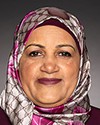I don't work specifically with Kermanji. I said at the outset that there's a restricted number of languages that our program trains for specifically. I can comment more broadly on what it means to try to train people who work with languages of lesser diffusion.
One of the things we notice very often is that there's a pattern when a new group of people comes to the country. What tends to happen is they start showing up at community-level services. It's at this level that the whole interpreting infrastructure first takes note. All of a sudden a hospital is saying it needs Kermanji, and community centres are saying they need Kermanji. It's up to the agencies and the training institutions to try to respond. We don't really get a first alert, if you will, to say, “Hey, by the way, we're about to bring in this new wave of people. These are their language needs, and can you come to it and snap to attention.”
This is different from what we see elsewhere. For example, I contrast this with conference interpreting at the European institutions, where each time there's even the remote possibility that a new member state will be added and a new language will enter into the mix, there's a whole cadre of people who spring into action and start preparing for language services to be provided. We could do a little bit to imitate that pattern.



